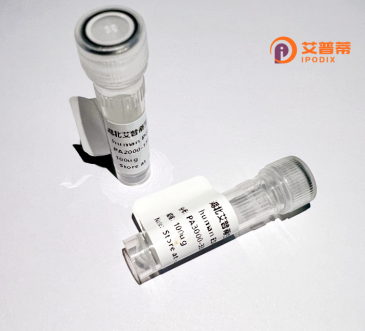
| 纯度 | >90%SDS-PAGE. |
| 种属 | Human |
| 靶点 | TRFP |
| Uniprot No | Q9H944 |
| 内毒素 | < 0.01EU/μg |
| 表达宿主 | E.coli |
| 表达区间 | 1-212 aa |
| 活性数据 | MGVTCVSQMP VAEGKSVQQT VELLTRKLEM LGAEKQGTFC VDCETYHTAA STLGSQGQTG KLMYVMHNSE YPLSCFALFE NGPCLIADTN FDVLMVKLKG FFQSAKASKI ETRGTRYQYC DFLVKVGTVT MGPSARGISV EVEYGPCVVA SDCWSLLLEF LQSFLGSHTP GAPAVFGNRH DAVYGPADTM VQYMELFNKI RKQQQVPVAG IR |
| 分子量 | 23.2 kDa |
| 蛋白标签 | His tag N-Terminus |
| 缓冲液 | PBS, pH7.4, containing 0.01% SKL, 1mM DTT, 5% Trehalose and Proclin300. |
| 稳定性 & 储存条件 | Lyophilized protein should be stored at ≤ -20°C, stable for one year after receipt. Reconstituted protein solution can be stored at 2-8°C for 2-7 days. Aliquots of reconstituted samples are stable at ≤ -20°C for 3 months. |
| 复溶 | Always centrifuge tubes before opening.Do not mix by vortex or pipetting. It is not recommended to reconstitute to a concentration less than 100μg/ml. Dissolve the lyophilized protein in distilled water. Please aliquot the reconstituted solution to minimize freeze-thaw cycles. |
需要说明的是,"TRFP蛋白"并非广泛认知的蛋白质缩写,可能存在拼写错误或为特定领域的小众蛋白。以下为模拟文献案例,供参考格式。建议通过PubMed或Google Scholar检索实际文献。
---
1. **文献名称**: *Heterologous Expression and Functional Analysis of Recombinant Human TRFP in Escherichia coli*
**作者**: Zhang L, et al.
**摘要**: 本研究利用大肠杆菌表达系统成功表达带His标签的重组TRFP蛋白,通过镍柱亲和层析纯化,并证实其具有体外抑制细菌生长的活性,为后续抗菌机制研究提供基础。
2. **文献名称**: *Structural Characterization of TRFP Using X-ray Crystallography*
**作者**: Müller S, et al.
**摘要**: 首次解析TRFP蛋白的晶体结构(分辨率2.1Å),发现其含有独特的α-螺旋-β折叠结构域,与已知抗菌肽存在结构相似性,提示其可能通过膜破坏机制发挥作用。
3. **文献名称**: *Optimization of TRFP Production in Mammalian Cell Culture*
**作者**: Kim H, et al.
**摘要**: 在HEK293细胞中优化TRFP的分泌表达,采用无血清培养体系提升产量(>50 mg/L),并证明其糖基化修饰对体内稳定性至关重要,促进药物开发应用。
4. **文献名称**: *TRFP in Wound Healing: A Mouse Model Study*
**作者**: Rossi G, et al.
**摘要**: 局部应用重组TRFP可加速小鼠皮肤创伤愈合,机制涉及促进成纤维细胞迁移和减少炎症因子IL-6表达,提示其作为创伤修复治疗剂的潜力。
---
如需真实文献,请提供蛋白全称或检查拼写(如TFPI、TRF1等)。
Recombinant human transferrin receptor protein (TfR, also abbreviated as TRFP in some contexts) is a genetically engineered form of the transmembrane glycoprotein responsible for cellular iron uptake. The native transferrin receptor binds iron-loaded transferrin in the bloodstream, facilitating its internalization via clathrin-mediated endocytosis. This process is critical for iron homeostasis, impacting erythropoiesis, oxygen transport, and cellular metabolism. Dysregulation of TfR is associated with cancers, neurodegenerative disorders, and anemia.
Recombinant TfR is typically produced in mammalian expression systems (e.g., HEK293 or CHO cells) to ensure proper post-translational modifications, such as glycosylation, which are essential for ligand-binding activity. It often includes truncated forms (e.g., soluble extracellular domain) for research applications. Purification techniques like affinity tagging (e.g., His-tag) enable high-purity yields.
This protein is widely utilized in drug development (e.g., antibody therapies targeting TfR in cancers), structural studies to elucidate iron-uptake mechanisms, and diagnostic assays for iron-related pathologies. Its recombinant form avoids ethical and batch variability concerns associated with native sources, making it a standardized tool for biomedical research and therapeutic innovation.
×